Leadership Management
VerifiedAdded on 2023/01/10
|12
|3709
|41
AI Summary
Please answer the questions from page 7 page 11 page 13 page 14 page 15 page 19 page 20 page 21 page 22 page 24 Thank you
Contribute Materials
Your contribution can guide someone’s learning journey. Share your
documents today.
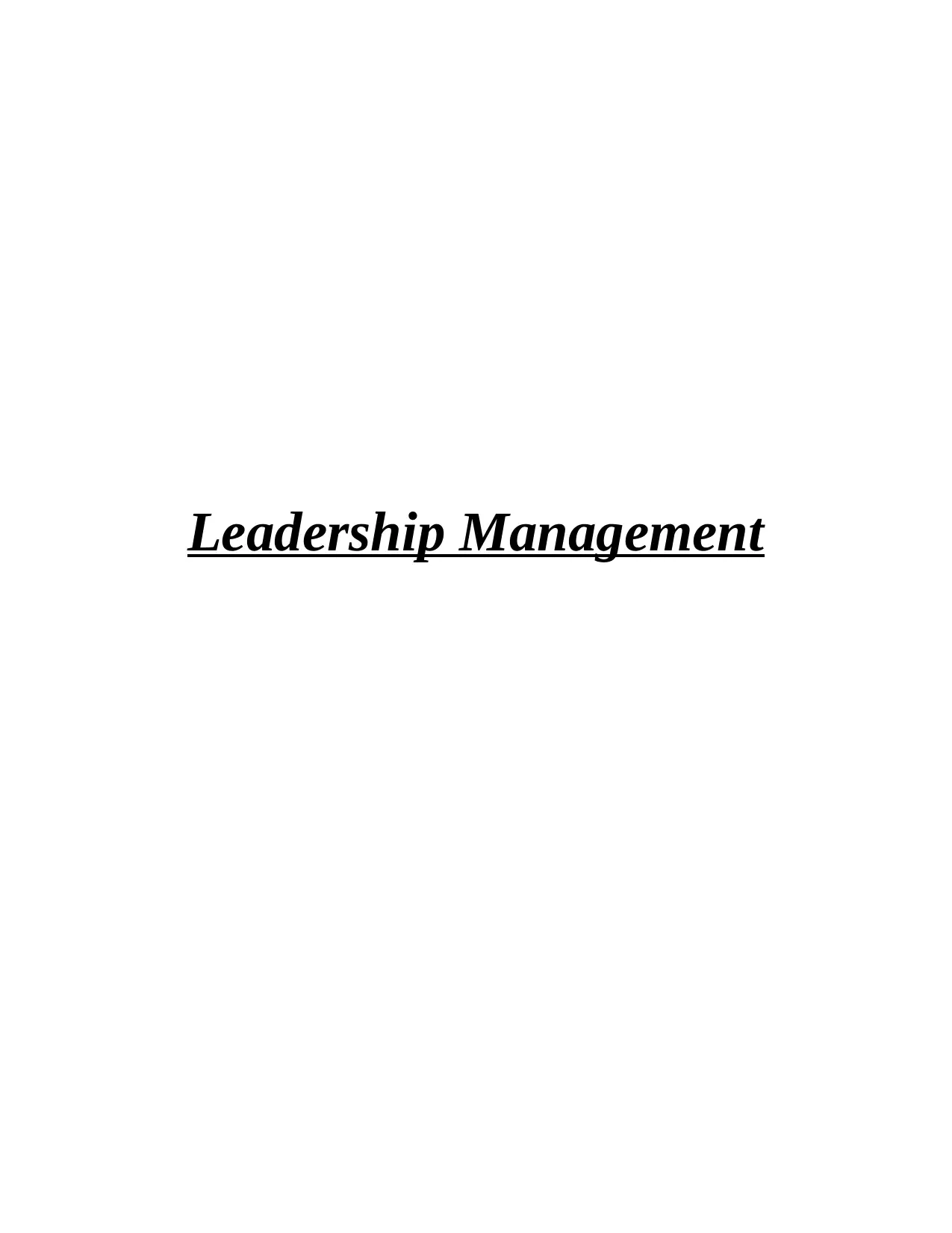
Leadership Management
Secure Best Marks with AI Grader
Need help grading? Try our AI Grader for instant feedback on your assignments.
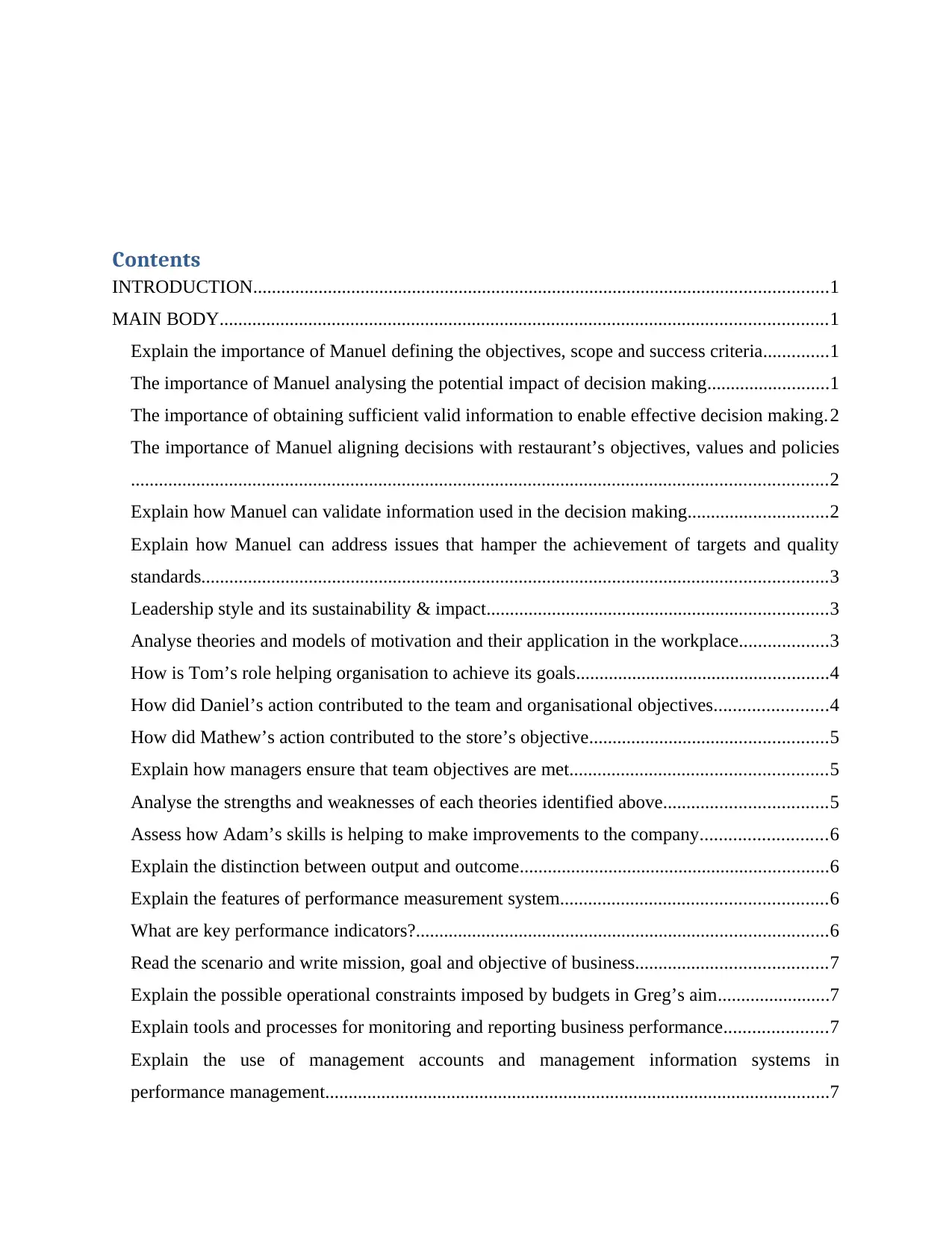
Contents
INTRODUCTION...........................................................................................................................1
MAIN BODY..................................................................................................................................1
Explain the importance of Manuel defining the objectives, scope and success criteria..............1
The importance of Manuel analysing the potential impact of decision making..........................1
The importance of obtaining sufficient valid information to enable effective decision making.2
The importance of Manuel aligning decisions with restaurant’s objectives, values and policies
.....................................................................................................................................................2
Explain how Manuel can validate information used in the decision making..............................2
Explain how Manuel can address issues that hamper the achievement of targets and quality
standards......................................................................................................................................3
Leadership style and its sustainability & impact.........................................................................3
Analyse theories and models of motivation and their application in the workplace...................3
How is Tom’s role helping organisation to achieve its goals......................................................4
How did Daniel’s action contributed to the team and organisational objectives........................4
How did Mathew’s action contributed to the store’s objective...................................................5
Explain how managers ensure that team objectives are met.......................................................5
Analyse the strengths and weaknesses of each theories identified above...................................5
Assess how Adam’s skills is helping to make improvements to the company...........................6
Explain the distinction between output and outcome..................................................................6
Explain the features of performance measurement system.........................................................6
What are key performance indicators?........................................................................................6
Read the scenario and write mission, goal and objective of business.........................................7
Explain the possible operational constraints imposed by budgets in Greg’s aim........................7
Explain tools and processes for monitoring and reporting business performance......................7
Explain the use of management accounts and management information systems in
performance management............................................................................................................7
INTRODUCTION...........................................................................................................................1
MAIN BODY..................................................................................................................................1
Explain the importance of Manuel defining the objectives, scope and success criteria..............1
The importance of Manuel analysing the potential impact of decision making..........................1
The importance of obtaining sufficient valid information to enable effective decision making.2
The importance of Manuel aligning decisions with restaurant’s objectives, values and policies
.....................................................................................................................................................2
Explain how Manuel can validate information used in the decision making..............................2
Explain how Manuel can address issues that hamper the achievement of targets and quality
standards......................................................................................................................................3
Leadership style and its sustainability & impact.........................................................................3
Analyse theories and models of motivation and their application in the workplace...................3
How is Tom’s role helping organisation to achieve its goals......................................................4
How did Daniel’s action contributed to the team and organisational objectives........................4
How did Mathew’s action contributed to the store’s objective...................................................5
Explain how managers ensure that team objectives are met.......................................................5
Analyse the strengths and weaknesses of each theories identified above...................................5
Assess how Adam’s skills is helping to make improvements to the company...........................6
Explain the distinction between output and outcome..................................................................6
Explain the features of performance measurement system.........................................................6
What are key performance indicators?........................................................................................6
Read the scenario and write mission, goal and objective of business.........................................7
Explain the possible operational constraints imposed by budgets in Greg’s aim........................7
Explain tools and processes for monitoring and reporting business performance......................7
Explain the use of management accounts and management information systems in
performance management............................................................................................................7
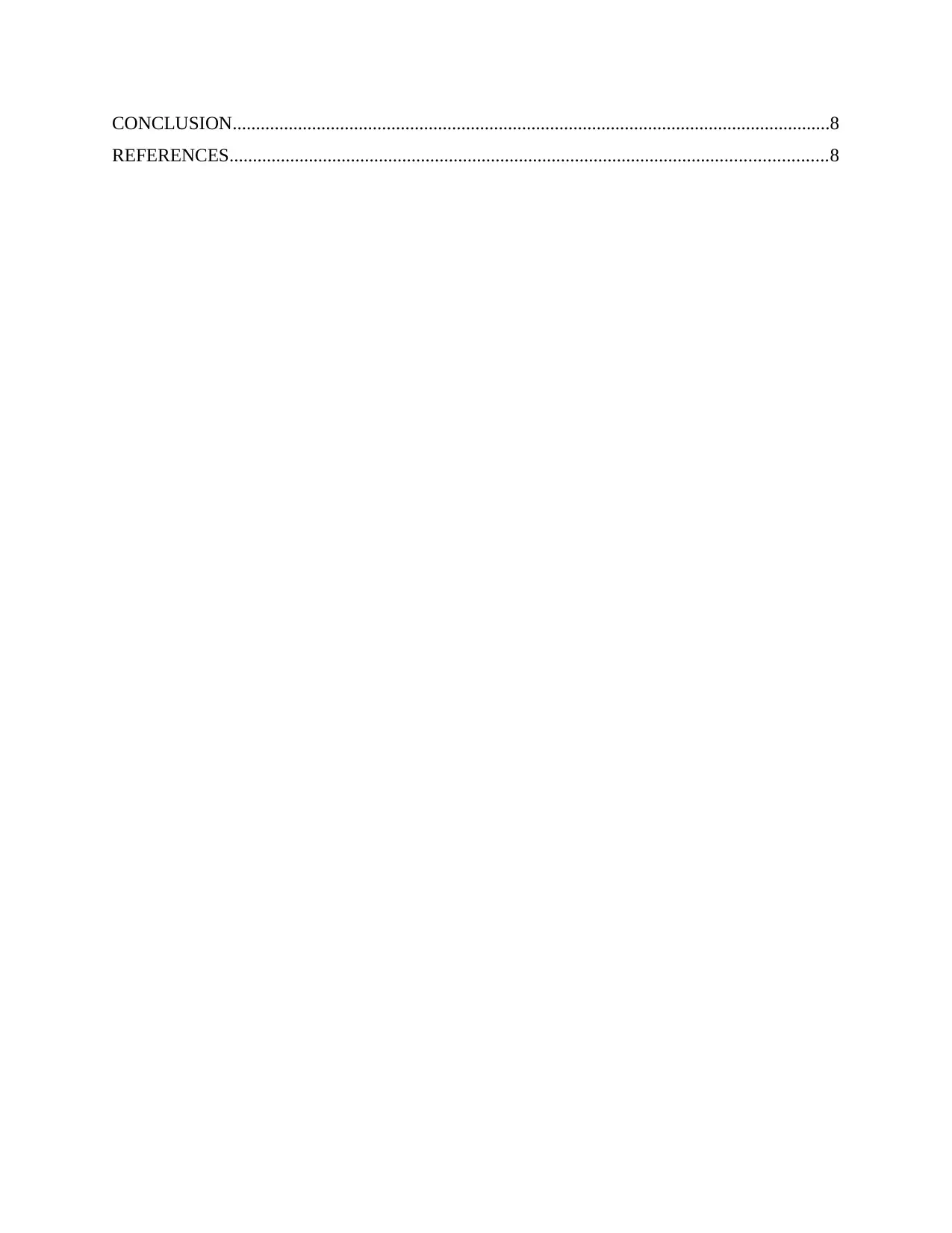
CONCLUSION................................................................................................................................8
REFERENCES................................................................................................................................8
REFERENCES................................................................................................................................8

INTRODUCTION
Leadership is all about getting people to comprehend and believe in the vision that is set by
the leader for the company and to work with the venture on accomplishing its aims and
objectives. Whereas management is more about managing and ensuring the day to day business
practices are happening as they should (Bush, Bell and Middlewood, 2019). In leadership, the
leader direct and guide employees to execute the assigned work and accomplish the goals of
business while in management, the manager frame plans and strategies so that workforce can
perform their work in systematic manner by considering them. This written document is based
on different concepts of leadership and management. The document will cover information about
decision making, leadership styles, motivation theories, roles & functions of management,
leadership and management conceptions, performance management and management
information systems etc.
MAIN BODY
Explain the importance of Manuel defining the objectives, scope and success criteria
The decision that is taken by Manuel is good and has large scope as the person decided to
open a restaurant with the objective of opening a trendy fine dining establishment catering to
young, urban professionals. This business objective, scope and success criteria of the decisions
are most crucial because the individual decided to open its restaurant in trendy area of the city
that is undergoing an urban renewal with upcoming young professionals as its occupants. When
the venture able to attract number of consumers then sales and profits will also increase which is
beneficial for the firm and the person can easily pay its rent of restaurant.
The importance of Manuel analysing the potential impact of decision making
Making determination is certainly the most crucial task of Manuel and often it can be a
very complex one. The person want to take better decision for the company, therefore, Manuel
must assure the individual has the effective assets to deliver the accurate outcomes. For instance,
to make effective determination, the person must be able to collect and determine reliable data,
observe any legal requirement i.e. does the work meet with ethical, moral and financial view of
the business, Therefore appropriately the standards the venture requires (Weiss, Tappen and
Grimley, 2019). The accurate decision making regarding opening a business of restaurant is
beneficial as it will assist in offering profits to the individuals. It is important as it finds out the
1
Leadership is all about getting people to comprehend and believe in the vision that is set by
the leader for the company and to work with the venture on accomplishing its aims and
objectives. Whereas management is more about managing and ensuring the day to day business
practices are happening as they should (Bush, Bell and Middlewood, 2019). In leadership, the
leader direct and guide employees to execute the assigned work and accomplish the goals of
business while in management, the manager frame plans and strategies so that workforce can
perform their work in systematic manner by considering them. This written document is based
on different concepts of leadership and management. The document will cover information about
decision making, leadership styles, motivation theories, roles & functions of management,
leadership and management conceptions, performance management and management
information systems etc.
MAIN BODY
Explain the importance of Manuel defining the objectives, scope and success criteria
The decision that is taken by Manuel is good and has large scope as the person decided to
open a restaurant with the objective of opening a trendy fine dining establishment catering to
young, urban professionals. This business objective, scope and success criteria of the decisions
are most crucial because the individual decided to open its restaurant in trendy area of the city
that is undergoing an urban renewal with upcoming young professionals as its occupants. When
the venture able to attract number of consumers then sales and profits will also increase which is
beneficial for the firm and the person can easily pay its rent of restaurant.
The importance of Manuel analysing the potential impact of decision making
Making determination is certainly the most crucial task of Manuel and often it can be a
very complex one. The person want to take better decision for the company, therefore, Manuel
must assure the individual has the effective assets to deliver the accurate outcomes. For instance,
to make effective determination, the person must be able to collect and determine reliable data,
observe any legal requirement i.e. does the work meet with ethical, moral and financial view of
the business, Therefore appropriately the standards the venture requires (Weiss, Tappen and
Grimley, 2019). The accurate decision making regarding opening a business of restaurant is
beneficial as it will assist in offering profits to the individuals. It is important as it finds out the
1
Paraphrase This Document
Need a fresh take? Get an instant paraphrase of this document with our AI Paraphraser
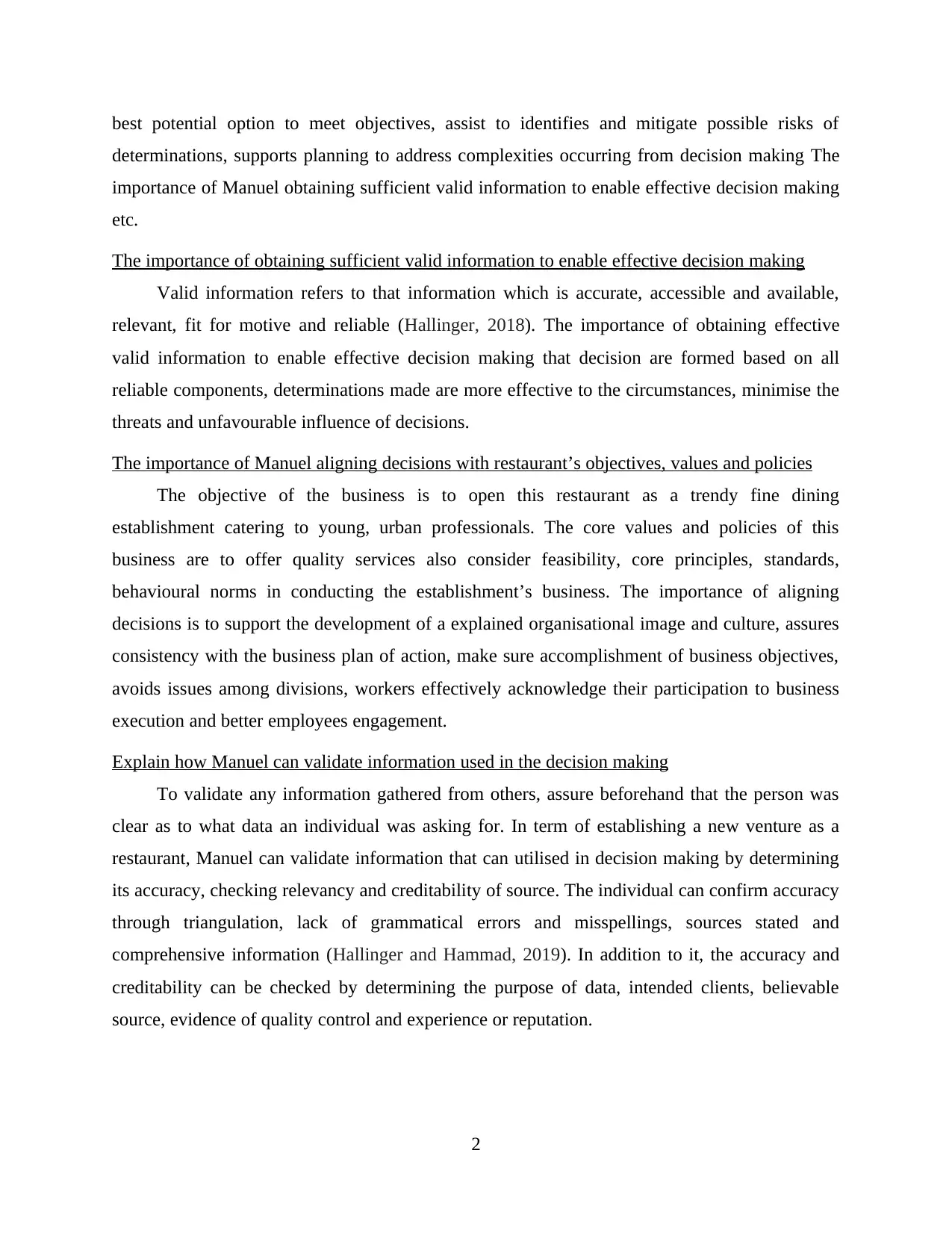
best potential option to meet objectives, assist to identifies and mitigate possible risks of
determinations, supports planning to address complexities occurring from decision making The
importance of Manuel obtaining sufficient valid information to enable effective decision making
etc.
The importance of obtaining sufficient valid information to enable effective decision making
Valid information refers to that information which is accurate, accessible and available,
relevant, fit for motive and reliable (Hallinger, 2018). The importance of obtaining effective
valid information to enable effective decision making that decision are formed based on all
reliable components, determinations made are more effective to the circumstances, minimise the
threats and unfavourable influence of decisions.
The importance of Manuel aligning decisions with restaurant’s objectives, values and policies
The objective of the business is to open this restaurant as a trendy fine dining
establishment catering to young, urban professionals. The core values and policies of this
business are to offer quality services also consider feasibility, core principles, standards,
behavioural norms in conducting the establishment’s business. The importance of aligning
decisions is to support the development of a explained organisational image and culture, assures
consistency with the business plan of action, make sure accomplishment of business objectives,
avoids issues among divisions, workers effectively acknowledge their participation to business
execution and better employees engagement.
Explain how Manuel can validate information used in the decision making
To validate any information gathered from others, assure beforehand that the person was
clear as to what data an individual was asking for. In term of establishing a new venture as a
restaurant, Manuel can validate information that can utilised in decision making by determining
its accuracy, checking relevancy and creditability of source. The individual can confirm accuracy
through triangulation, lack of grammatical errors and misspellings, sources stated and
comprehensive information (Hallinger and Hammad, 2019). In addition to it, the accuracy and
creditability can be checked by determining the purpose of data, intended clients, believable
source, evidence of quality control and experience or reputation.
2
determinations, supports planning to address complexities occurring from decision making The
importance of Manuel obtaining sufficient valid information to enable effective decision making
etc.
The importance of obtaining sufficient valid information to enable effective decision making
Valid information refers to that information which is accurate, accessible and available,
relevant, fit for motive and reliable (Hallinger, 2018). The importance of obtaining effective
valid information to enable effective decision making that decision are formed based on all
reliable components, determinations made are more effective to the circumstances, minimise the
threats and unfavourable influence of decisions.
The importance of Manuel aligning decisions with restaurant’s objectives, values and policies
The objective of the business is to open this restaurant as a trendy fine dining
establishment catering to young, urban professionals. The core values and policies of this
business are to offer quality services also consider feasibility, core principles, standards,
behavioural norms in conducting the establishment’s business. The importance of aligning
decisions is to support the development of a explained organisational image and culture, assures
consistency with the business plan of action, make sure accomplishment of business objectives,
avoids issues among divisions, workers effectively acknowledge their participation to business
execution and better employees engagement.
Explain how Manuel can validate information used in the decision making
To validate any information gathered from others, assure beforehand that the person was
clear as to what data an individual was asking for. In term of establishing a new venture as a
restaurant, Manuel can validate information that can utilised in decision making by determining
its accuracy, checking relevancy and creditability of source. The individual can confirm accuracy
through triangulation, lack of grammatical errors and misspellings, sources stated and
comprehensive information (Hallinger and Hammad, 2019). In addition to it, the accuracy and
creditability can be checked by determining the purpose of data, intended clients, believable
source, evidence of quality control and experience or reputation.
2
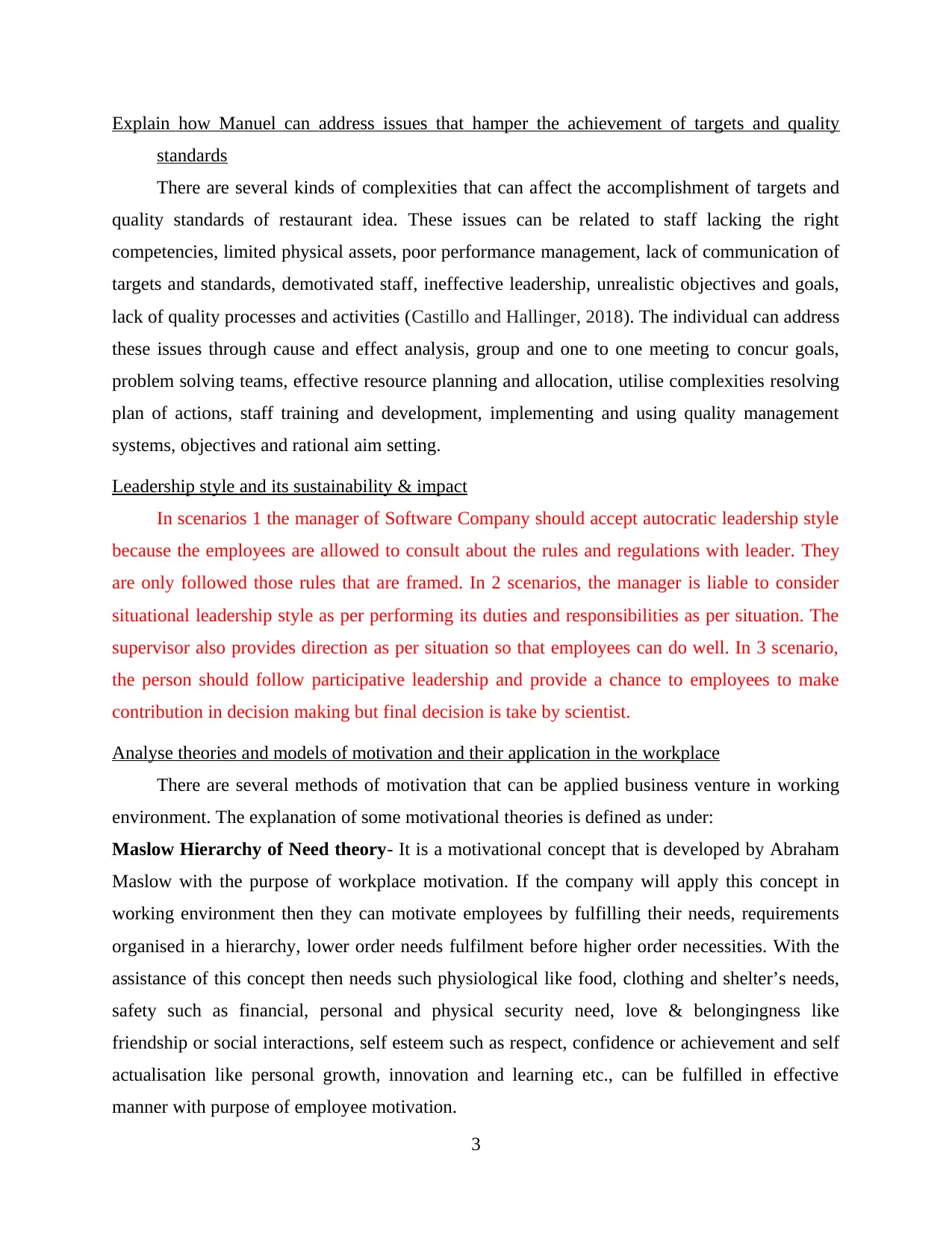
Explain how Manuel can address issues that hamper the achievement of targets and quality
standards
There are several kinds of complexities that can affect the accomplishment of targets and
quality standards of restaurant idea. These issues can be related to staff lacking the right
competencies, limited physical assets, poor performance management, lack of communication of
targets and standards, demotivated staff, ineffective leadership, unrealistic objectives and goals,
lack of quality processes and activities (Castillo and Hallinger, 2018). The individual can address
these issues through cause and effect analysis, group and one to one meeting to concur goals,
problem solving teams, effective resource planning and allocation, utilise complexities resolving
plan of actions, staff training and development, implementing and using quality management
systems, objectives and rational aim setting.
Leadership style and its sustainability & impact
In scenarios 1 the manager of Software Company should accept autocratic leadership style
because the employees are allowed to consult about the rules and regulations with leader. They
are only followed those rules that are framed. In 2 scenarios, the manager is liable to consider
situational leadership style as per performing its duties and responsibilities as per situation. The
supervisor also provides direction as per situation so that employees can do well. In 3 scenario,
the person should follow participative leadership and provide a chance to employees to make
contribution in decision making but final decision is take by scientist.
Analyse theories and models of motivation and their application in the workplace
There are several methods of motivation that can be applied business venture in working
environment. The explanation of some motivational theories is defined as under:
Maslow Hierarchy of Need theory- It is a motivational concept that is developed by Abraham
Maslow with the purpose of workplace motivation. If the company will apply this concept in
working environment then they can motivate employees by fulfilling their needs, requirements
organised in a hierarchy, lower order needs fulfilment before higher order necessities. With the
assistance of this concept then needs such physiological like food, clothing and shelter’s needs,
safety such as financial, personal and physical security need, love & belongingness like
friendship or social interactions, self esteem such as respect, confidence or achievement and self
actualisation like personal growth, innovation and learning etc., can be fulfilled in effective
manner with purpose of employee motivation.
3
standards
There are several kinds of complexities that can affect the accomplishment of targets and
quality standards of restaurant idea. These issues can be related to staff lacking the right
competencies, limited physical assets, poor performance management, lack of communication of
targets and standards, demotivated staff, ineffective leadership, unrealistic objectives and goals,
lack of quality processes and activities (Castillo and Hallinger, 2018). The individual can address
these issues through cause and effect analysis, group and one to one meeting to concur goals,
problem solving teams, effective resource planning and allocation, utilise complexities resolving
plan of actions, staff training and development, implementing and using quality management
systems, objectives and rational aim setting.
Leadership style and its sustainability & impact
In scenarios 1 the manager of Software Company should accept autocratic leadership style
because the employees are allowed to consult about the rules and regulations with leader. They
are only followed those rules that are framed. In 2 scenarios, the manager is liable to consider
situational leadership style as per performing its duties and responsibilities as per situation. The
supervisor also provides direction as per situation so that employees can do well. In 3 scenario,
the person should follow participative leadership and provide a chance to employees to make
contribution in decision making but final decision is take by scientist.
Analyse theories and models of motivation and their application in the workplace
There are several methods of motivation that can be applied business venture in working
environment. The explanation of some motivational theories is defined as under:
Maslow Hierarchy of Need theory- It is a motivational concept that is developed by Abraham
Maslow with the purpose of workplace motivation. If the company will apply this concept in
working environment then they can motivate employees by fulfilling their needs, requirements
organised in a hierarchy, lower order needs fulfilment before higher order necessities. With the
assistance of this concept then needs such physiological like food, clothing and shelter’s needs,
safety such as financial, personal and physical security need, love & belongingness like
friendship or social interactions, self esteem such as respect, confidence or achievement and self
actualisation like personal growth, innovation and learning etc., can be fulfilled in effective
manner with purpose of employee motivation.
3
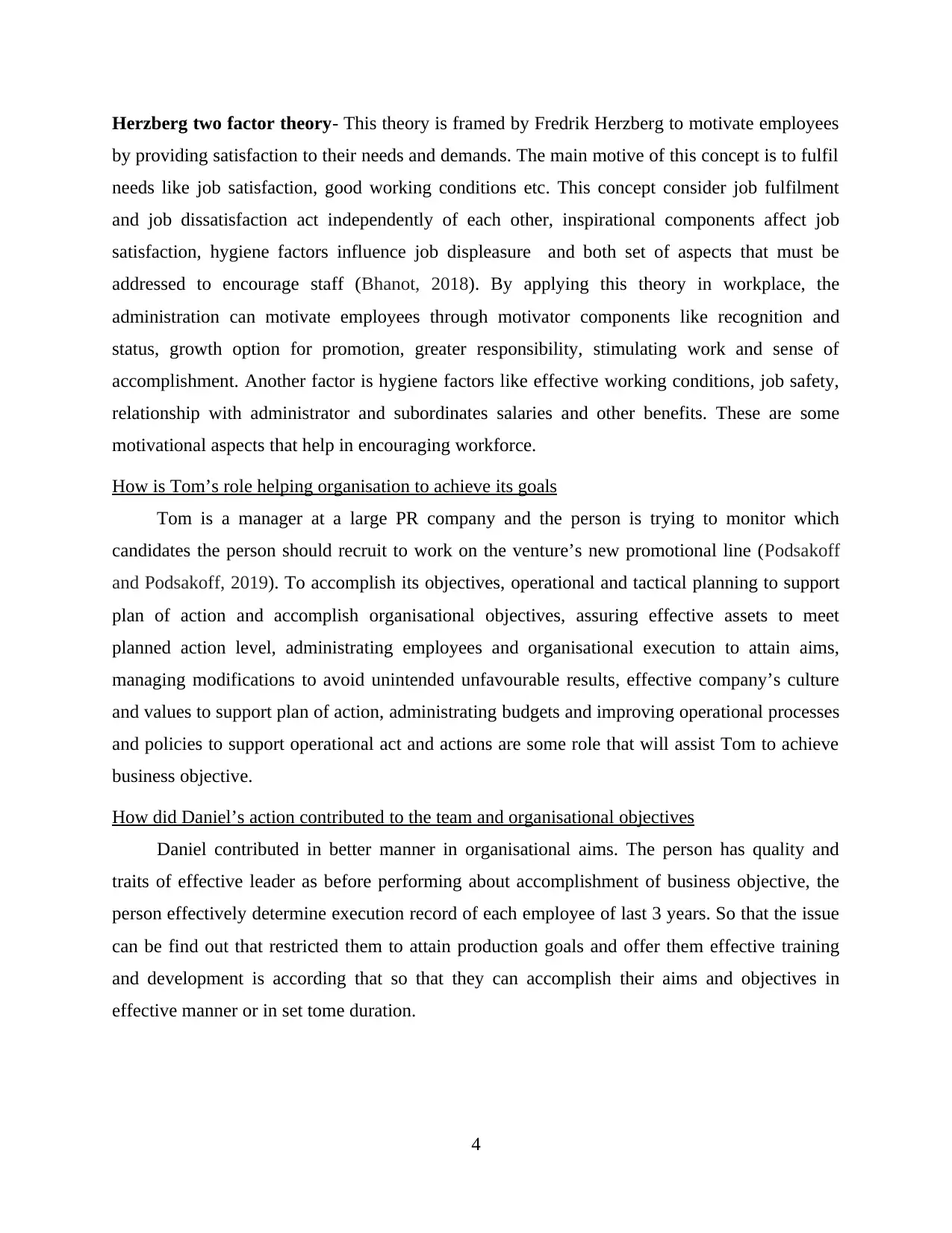
Herzberg two factor theory- This theory is framed by Fredrik Herzberg to motivate employees
by providing satisfaction to their needs and demands. The main motive of this concept is to fulfil
needs like job satisfaction, good working conditions etc. This concept consider job fulfilment
and job dissatisfaction act independently of each other, inspirational components affect job
satisfaction, hygiene factors influence job displeasure and both set of aspects that must be
addressed to encourage staff (Bhanot, 2018). By applying this theory in workplace, the
administration can motivate employees through motivator components like recognition and
status, growth option for promotion, greater responsibility, stimulating work and sense of
accomplishment. Another factor is hygiene factors like effective working conditions, job safety,
relationship with administrator and subordinates salaries and other benefits. These are some
motivational aspects that help in encouraging workforce.
How is Tom’s role helping organisation to achieve its goals
Tom is a manager at a large PR company and the person is trying to monitor which
candidates the person should recruit to work on the venture’s new promotional line (Podsakoff
and Podsakoff, 2019). To accomplish its objectives, operational and tactical planning to support
plan of action and accomplish organisational objectives, assuring effective assets to meet
planned action level, administrating employees and organisational execution to attain aims,
managing modifications to avoid unintended unfavourable results, effective company’s culture
and values to support plan of action, administrating budgets and improving operational processes
and policies to support operational act and actions are some role that will assist Tom to achieve
business objective.
How did Daniel’s action contributed to the team and organisational objectives
Daniel contributed in better manner in organisational aims. The person has quality and
traits of effective leader as before performing about accomplishment of business objective, the
person effectively determine execution record of each employee of last 3 years. So that the issue
can be find out that restricted them to attain production goals and offer them effective training
and development is according that so that they can accomplish their aims and objectives in
effective manner or in set tome duration.
4
by providing satisfaction to their needs and demands. The main motive of this concept is to fulfil
needs like job satisfaction, good working conditions etc. This concept consider job fulfilment
and job dissatisfaction act independently of each other, inspirational components affect job
satisfaction, hygiene factors influence job displeasure and both set of aspects that must be
addressed to encourage staff (Bhanot, 2018). By applying this theory in workplace, the
administration can motivate employees through motivator components like recognition and
status, growth option for promotion, greater responsibility, stimulating work and sense of
accomplishment. Another factor is hygiene factors like effective working conditions, job safety,
relationship with administrator and subordinates salaries and other benefits. These are some
motivational aspects that help in encouraging workforce.
How is Tom’s role helping organisation to achieve its goals
Tom is a manager at a large PR company and the person is trying to monitor which
candidates the person should recruit to work on the venture’s new promotional line (Podsakoff
and Podsakoff, 2019). To accomplish its objectives, operational and tactical planning to support
plan of action and accomplish organisational objectives, assuring effective assets to meet
planned action level, administrating employees and organisational execution to attain aims,
managing modifications to avoid unintended unfavourable results, effective company’s culture
and values to support plan of action, administrating budgets and improving operational processes
and policies to support operational act and actions are some role that will assist Tom to achieve
business objective.
How did Daniel’s action contributed to the team and organisational objectives
Daniel contributed in better manner in organisational aims. The person has quality and
traits of effective leader as before performing about accomplishment of business objective, the
person effectively determine execution record of each employee of last 3 years. So that the issue
can be find out that restricted them to attain production goals and offer them effective training
and development is according that so that they can accomplish their aims and objectives in
effective manner or in set tome duration.
4
Secure Best Marks with AI Grader
Need help grading? Try our AI Grader for instant feedback on your assignments.
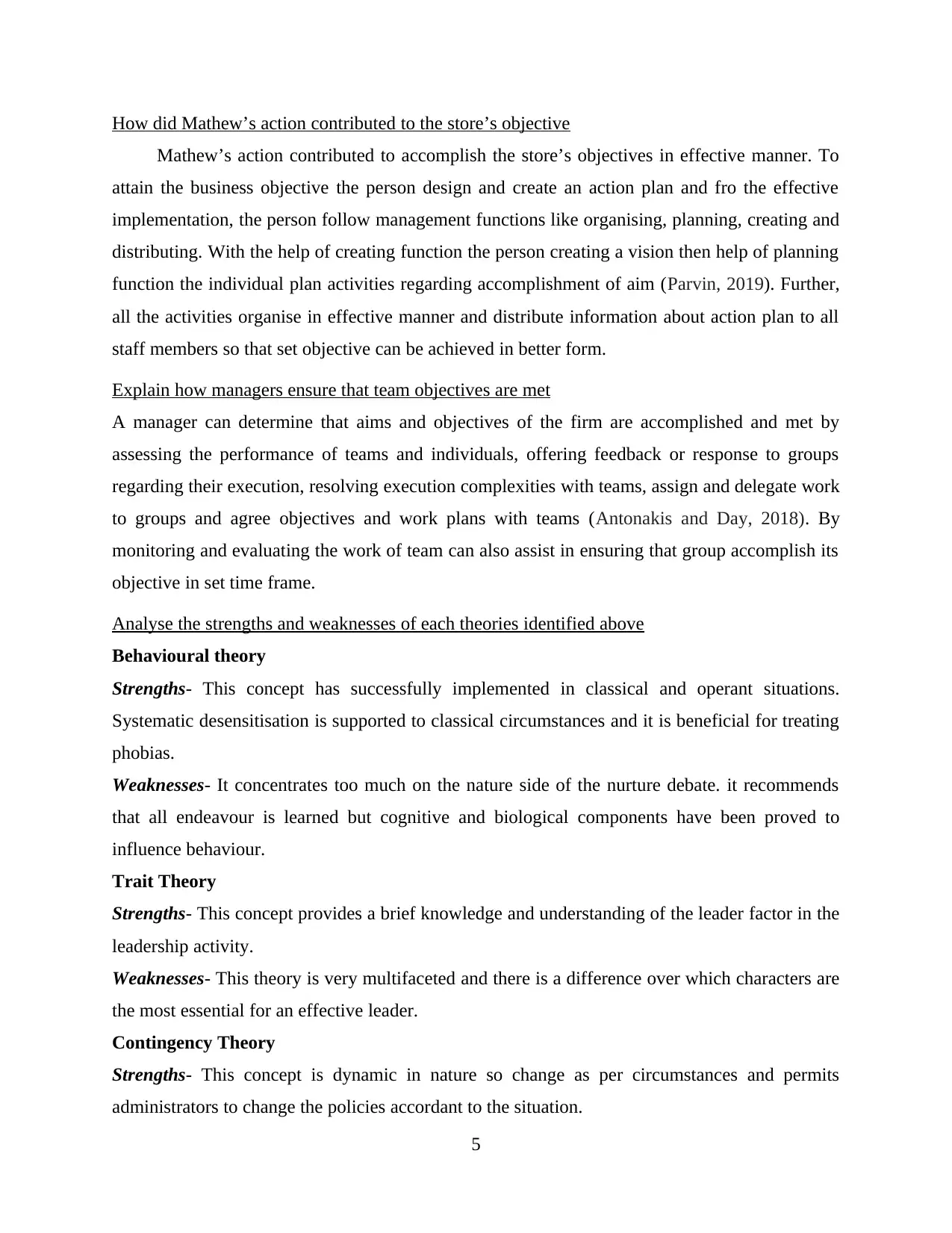
How did Mathew’s action contributed to the store’s objective
Mathew’s action contributed to accomplish the store’s objectives in effective manner. To
attain the business objective the person design and create an action plan and fro the effective
implementation, the person follow management functions like organising, planning, creating and
distributing. With the help of creating function the person creating a vision then help of planning
function the individual plan activities regarding accomplishment of aim (Parvin, 2019). Further,
all the activities organise in effective manner and distribute information about action plan to all
staff members so that set objective can be achieved in better form.
Explain how managers ensure that team objectives are met
A manager can determine that aims and objectives of the firm are accomplished and met by
assessing the performance of teams and individuals, offering feedback or response to groups
regarding their execution, resolving execution complexities with teams, assign and delegate work
to groups and agree objectives and work plans with teams (Antonakis and Day, 2018). By
monitoring and evaluating the work of team can also assist in ensuring that group accomplish its
objective in set time frame.
Analyse the strengths and weaknesses of each theories identified above
Behavioural theory
Strengths- This concept has successfully implemented in classical and operant situations.
Systematic desensitisation is supported to classical circumstances and it is beneficial for treating
phobias.
Weaknesses- It concentrates too much on the nature side of the nurture debate. it recommends
that all endeavour is learned but cognitive and biological components have been proved to
influence behaviour.
Trait Theory
Strengths- This concept provides a brief knowledge and understanding of the leader factor in the
leadership activity.
Weaknesses- This theory is very multifaceted and there is a difference over which characters are
the most essential for an effective leader.
Contingency Theory
Strengths- This concept is dynamic in nature so change as per circumstances and permits
administrators to change the policies accordant to the situation.
5
Mathew’s action contributed to accomplish the store’s objectives in effective manner. To
attain the business objective the person design and create an action plan and fro the effective
implementation, the person follow management functions like organising, planning, creating and
distributing. With the help of creating function the person creating a vision then help of planning
function the individual plan activities regarding accomplishment of aim (Parvin, 2019). Further,
all the activities organise in effective manner and distribute information about action plan to all
staff members so that set objective can be achieved in better form.
Explain how managers ensure that team objectives are met
A manager can determine that aims and objectives of the firm are accomplished and met by
assessing the performance of teams and individuals, offering feedback or response to groups
regarding their execution, resolving execution complexities with teams, assign and delegate work
to groups and agree objectives and work plans with teams (Antonakis and Day, 2018). By
monitoring and evaluating the work of team can also assist in ensuring that group accomplish its
objective in set time frame.
Analyse the strengths and weaknesses of each theories identified above
Behavioural theory
Strengths- This concept has successfully implemented in classical and operant situations.
Systematic desensitisation is supported to classical circumstances and it is beneficial for treating
phobias.
Weaknesses- It concentrates too much on the nature side of the nurture debate. it recommends
that all endeavour is learned but cognitive and biological components have been proved to
influence behaviour.
Trait Theory
Strengths- This concept provides a brief knowledge and understanding of the leader factor in the
leadership activity.
Weaknesses- This theory is very multifaceted and there is a difference over which characters are
the most essential for an effective leader.
Contingency Theory
Strengths- This concept is dynamic in nature so change as per circumstances and permits
administrators to change the policies accordant to the situation.
5
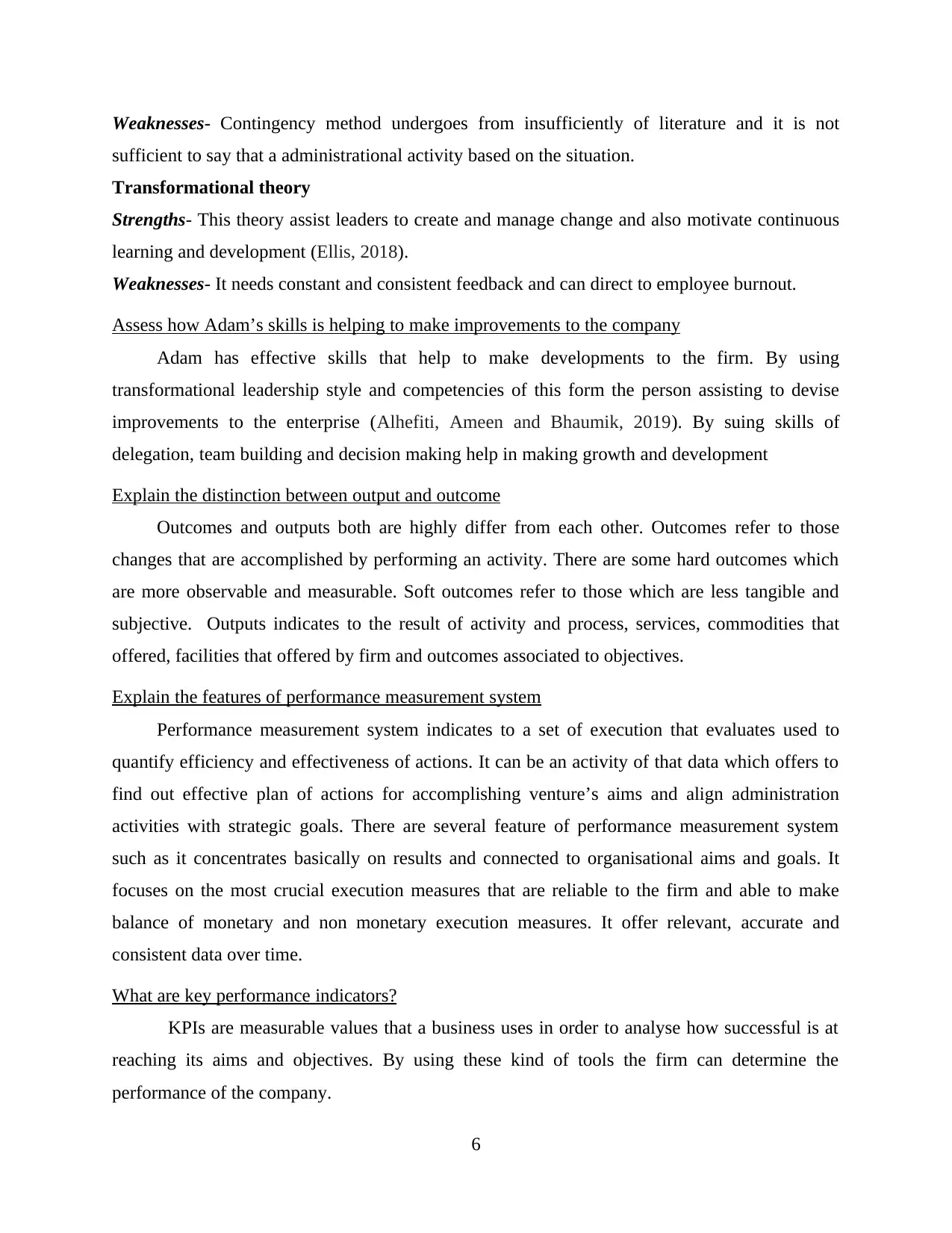
Weaknesses- Contingency method undergoes from insufficiently of literature and it is not
sufficient to say that a administrational activity based on the situation.
Transformational theory
Strengths- This theory assist leaders to create and manage change and also motivate continuous
learning and development (Ellis, 2018).
Weaknesses- It needs constant and consistent feedback and can direct to employee burnout.
Assess how Adam’s skills is helping to make improvements to the company
Adam has effective skills that help to make developments to the firm. By using
transformational leadership style and competencies of this form the person assisting to devise
improvements to the enterprise (Alhefiti, Ameen and Bhaumik, 2019). By suing skills of
delegation, team building and decision making help in making growth and development
Explain the distinction between output and outcome
Outcomes and outputs both are highly differ from each other. Outcomes refer to those
changes that are accomplished by performing an activity. There are some hard outcomes which
are more observable and measurable. Soft outcomes refer to those which are less tangible and
subjective. Outputs indicates to the result of activity and process, services, commodities that
offered, facilities that offered by firm and outcomes associated to objectives.
Explain the features of performance measurement system
Performance measurement system indicates to a set of execution that evaluates used to
quantify efficiency and effectiveness of actions. It can be an activity of that data which offers to
find out effective plan of actions for accomplishing venture’s aims and align administration
activities with strategic goals. There are several feature of performance measurement system
such as it concentrates basically on results and connected to organisational aims and goals. It
focuses on the most crucial execution measures that are reliable to the firm and able to make
balance of monetary and non monetary execution measures. It offer relevant, accurate and
consistent data over time.
What are key performance indicators?
KPIs are measurable values that a business uses in order to analyse how successful is at
reaching its aims and objectives. By using these kind of tools the firm can determine the
performance of the company.
6
sufficient to say that a administrational activity based on the situation.
Transformational theory
Strengths- This theory assist leaders to create and manage change and also motivate continuous
learning and development (Ellis, 2018).
Weaknesses- It needs constant and consistent feedback and can direct to employee burnout.
Assess how Adam’s skills is helping to make improvements to the company
Adam has effective skills that help to make developments to the firm. By using
transformational leadership style and competencies of this form the person assisting to devise
improvements to the enterprise (Alhefiti, Ameen and Bhaumik, 2019). By suing skills of
delegation, team building and decision making help in making growth and development
Explain the distinction between output and outcome
Outcomes and outputs both are highly differ from each other. Outcomes refer to those
changes that are accomplished by performing an activity. There are some hard outcomes which
are more observable and measurable. Soft outcomes refer to those which are less tangible and
subjective. Outputs indicates to the result of activity and process, services, commodities that
offered, facilities that offered by firm and outcomes associated to objectives.
Explain the features of performance measurement system
Performance measurement system indicates to a set of execution that evaluates used to
quantify efficiency and effectiveness of actions. It can be an activity of that data which offers to
find out effective plan of actions for accomplishing venture’s aims and align administration
activities with strategic goals. There are several feature of performance measurement system
such as it concentrates basically on results and connected to organisational aims and goals. It
focuses on the most crucial execution measures that are reliable to the firm and able to make
balance of monetary and non monetary execution measures. It offer relevant, accurate and
consistent data over time.
What are key performance indicators?
KPIs are measurable values that a business uses in order to analyse how successful is at
reaching its aims and objectives. By using these kind of tools the firm can determine the
performance of the company.
6
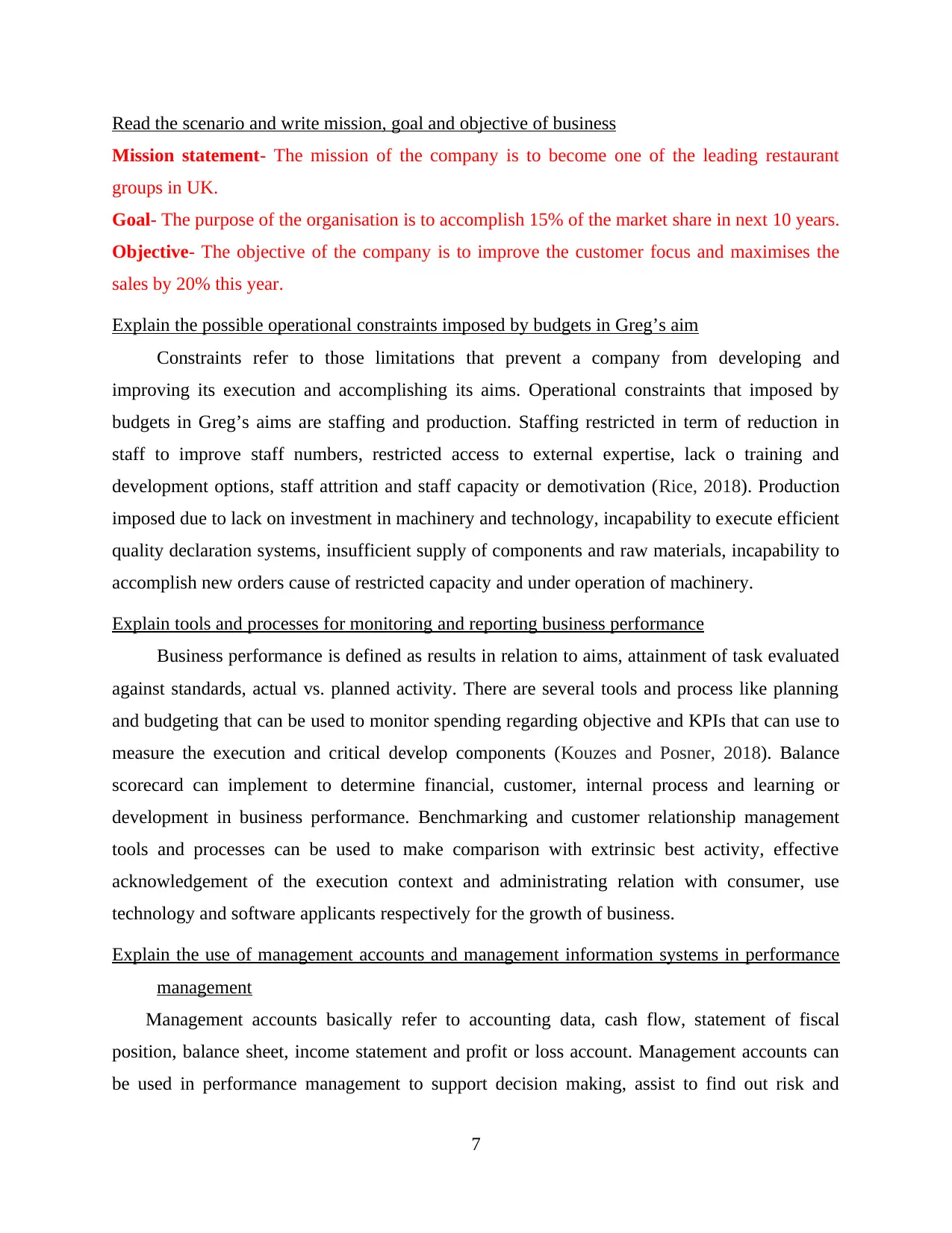
Read the scenario and write mission, goal and objective of business
Mission statement- The mission of the company is to become one of the leading restaurant
groups in UK.
Goal- The purpose of the organisation is to accomplish 15% of the market share in next 10 years.
Objective- The objective of the company is to improve the customer focus and maximises the
sales by 20% this year.
Explain the possible operational constraints imposed by budgets in Greg’s aim
Constraints refer to those limitations that prevent a company from developing and
improving its execution and accomplishing its aims. Operational constraints that imposed by
budgets in Greg’s aims are staffing and production. Staffing restricted in term of reduction in
staff to improve staff numbers, restricted access to external expertise, lack o training and
development options, staff attrition and staff capacity or demotivation (Rice, 2018). Production
imposed due to lack on investment in machinery and technology, incapability to execute efficient
quality declaration systems, insufficient supply of components and raw materials, incapability to
accomplish new orders cause of restricted capacity and under operation of machinery.
Explain tools and processes for monitoring and reporting business performance
Business performance is defined as results in relation to aims, attainment of task evaluated
against standards, actual vs. planned activity. There are several tools and process like planning
and budgeting that can be used to monitor spending regarding objective and KPIs that can use to
measure the execution and critical develop components (Kouzes and Posner, 2018). Balance
scorecard can implement to determine financial, customer, internal process and learning or
development in business performance. Benchmarking and customer relationship management
tools and processes can be used to make comparison with extrinsic best activity, effective
acknowledgement of the execution context and administrating relation with consumer, use
technology and software applicants respectively for the growth of business.
Explain the use of management accounts and management information systems in performance
management
Management accounts basically refer to accounting data, cash flow, statement of fiscal
position, balance sheet, income statement and profit or loss account. Management accounts can
be used in performance management to support decision making, assist to find out risk and
7
Mission statement- The mission of the company is to become one of the leading restaurant
groups in UK.
Goal- The purpose of the organisation is to accomplish 15% of the market share in next 10 years.
Objective- The objective of the company is to improve the customer focus and maximises the
sales by 20% this year.
Explain the possible operational constraints imposed by budgets in Greg’s aim
Constraints refer to those limitations that prevent a company from developing and
improving its execution and accomplishing its aims. Operational constraints that imposed by
budgets in Greg’s aims are staffing and production. Staffing restricted in term of reduction in
staff to improve staff numbers, restricted access to external expertise, lack o training and
development options, staff attrition and staff capacity or demotivation (Rice, 2018). Production
imposed due to lack on investment in machinery and technology, incapability to execute efficient
quality declaration systems, insufficient supply of components and raw materials, incapability to
accomplish new orders cause of restricted capacity and under operation of machinery.
Explain tools and processes for monitoring and reporting business performance
Business performance is defined as results in relation to aims, attainment of task evaluated
against standards, actual vs. planned activity. There are several tools and process like planning
and budgeting that can be used to monitor spending regarding objective and KPIs that can use to
measure the execution and critical develop components (Kouzes and Posner, 2018). Balance
scorecard can implement to determine financial, customer, internal process and learning or
development in business performance. Benchmarking and customer relationship management
tools and processes can be used to make comparison with extrinsic best activity, effective
acknowledgement of the execution context and administrating relation with consumer, use
technology and software applicants respectively for the growth of business.
Explain the use of management accounts and management information systems in performance
management
Management accounts basically refer to accounting data, cash flow, statement of fiscal
position, balance sheet, income statement and profit or loss account. Management accounts can
be used in performance management to support decision making, assist to find out risk and
7
Paraphrase This Document
Need a fresh take? Get an instant paraphrase of this document with our AI Paraphraser
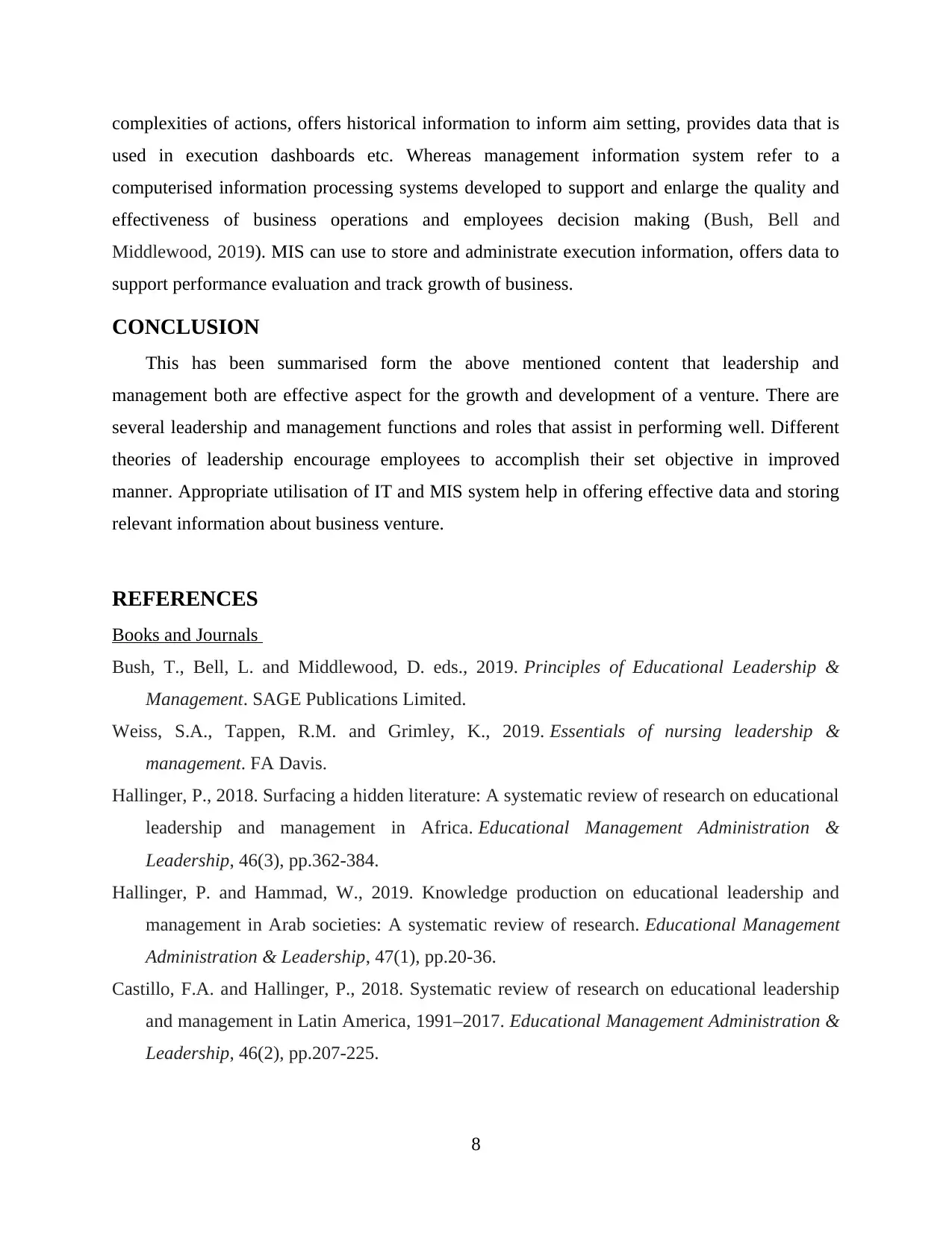
complexities of actions, offers historical information to inform aim setting, provides data that is
used in execution dashboards etc. Whereas management information system refer to a
computerised information processing systems developed to support and enlarge the quality and
effectiveness of business operations and employees decision making (Bush, Bell and
Middlewood, 2019). MIS can use to store and administrate execution information, offers data to
support performance evaluation and track growth of business.
CONCLUSION
This has been summarised form the above mentioned content that leadership and
management both are effective aspect for the growth and development of a venture. There are
several leadership and management functions and roles that assist in performing well. Different
theories of leadership encourage employees to accomplish their set objective in improved
manner. Appropriate utilisation of IT and MIS system help in offering effective data and storing
relevant information about business venture.
REFERENCES
Books and Journals
Bush, T., Bell, L. and Middlewood, D. eds., 2019. Principles of Educational Leadership &
Management. SAGE Publications Limited.
Weiss, S.A., Tappen, R.M. and Grimley, K., 2019. Essentials of nursing leadership &
management. FA Davis.
Hallinger, P., 2018. Surfacing a hidden literature: A systematic review of research on educational
leadership and management in Africa. Educational Management Administration &
Leadership, 46(3), pp.362-384.
Hallinger, P. and Hammad, W., 2019. Knowledge production on educational leadership and
management in Arab societies: A systematic review of research. Educational Management
Administration & Leadership, 47(1), pp.20-36.
Castillo, F.A. and Hallinger, P., 2018. Systematic review of research on educational leadership
and management in Latin America, 1991–2017. Educational Management Administration &
Leadership, 46(2), pp.207-225.
8
used in execution dashboards etc. Whereas management information system refer to a
computerised information processing systems developed to support and enlarge the quality and
effectiveness of business operations and employees decision making (Bush, Bell and
Middlewood, 2019). MIS can use to store and administrate execution information, offers data to
support performance evaluation and track growth of business.
CONCLUSION
This has been summarised form the above mentioned content that leadership and
management both are effective aspect for the growth and development of a venture. There are
several leadership and management functions and roles that assist in performing well. Different
theories of leadership encourage employees to accomplish their set objective in improved
manner. Appropriate utilisation of IT and MIS system help in offering effective data and storing
relevant information about business venture.
REFERENCES
Books and Journals
Bush, T., Bell, L. and Middlewood, D. eds., 2019. Principles of Educational Leadership &
Management. SAGE Publications Limited.
Weiss, S.A., Tappen, R.M. and Grimley, K., 2019. Essentials of nursing leadership &
management. FA Davis.
Hallinger, P., 2018. Surfacing a hidden literature: A systematic review of research on educational
leadership and management in Africa. Educational Management Administration &
Leadership, 46(3), pp.362-384.
Hallinger, P. and Hammad, W., 2019. Knowledge production on educational leadership and
management in Arab societies: A systematic review of research. Educational Management
Administration & Leadership, 47(1), pp.20-36.
Castillo, F.A. and Hallinger, P., 2018. Systematic review of research on educational leadership
and management in Latin America, 1991–2017. Educational Management Administration &
Leadership, 46(2), pp.207-225.
8

Bhanot, R., 2018. Improving leadership and management education in medical school. Advances
in medical education and practice, 9, p.305.
Podsakoff, P.M. and Podsakoff, N.P., 2019. Experimental designs in management and leadership
research: Strengths, limitations, and recommendations for improving publishability. The
Leadership Quarterly, 30(1), pp.11-33.
Parvin, A., 2019. Leadership and management in quality assurance: insights from the context of
Khulna University, Bangladesh. Higher Education, 77(4), pp.739-756.
Antonakis, J. and Day, D.V., 2018. Leadership: Past, present, and future.
Ellis, P., 2018. Leadership, management and team working in nursing. Learning Matters.
Alhefiti, S., Ameen, A. and Bhaumik, A., 2019. The Impact of the Leadership and Strategy
Management on Organizational Excellence: Moderating role of Organizational
Culture. Journal of Advanced Research in Dynamical and Control Systems, (06-Special
Issue), pp.748-759.
Rice, A.K., 2018. Learning for leadership: Interpersonal and intergroup relations. Routledge.
Kouzes, J.M. and Posner, B.Z., 2018. The student leadership challenge: Five practices for
becoming an exemplary leader. John Wiley & Sons.
Online
Strengths and Weaknesses of Behavioural Approach. 2020. [Online]. Available Through: <
https://getrevising.co.uk/grids/strengths_and_weaknesses_of_behavioural_approach>.
Trait Theory of Leadership. 2020. [Online]. Available Through: <
https://managementstudyguide.com/trait-theory-of-leadership.htm>.
Advantages and Disadvantages of Contingency Approach to Management. 2020. [Online].
Available Through: < https://commercemates.com/advantages-disadvantages-contingency-
approach/>.
Advantages and Disadvantages of Transformational Leadership.. 2020. [Online]. Available
Through: < https://brandongaille.com/22-advantages-and-disadvantages-of-transformational-
leadership/>.
9
in medical education and practice, 9, p.305.
Podsakoff, P.M. and Podsakoff, N.P., 2019. Experimental designs in management and leadership
research: Strengths, limitations, and recommendations for improving publishability. The
Leadership Quarterly, 30(1), pp.11-33.
Parvin, A., 2019. Leadership and management in quality assurance: insights from the context of
Khulna University, Bangladesh. Higher Education, 77(4), pp.739-756.
Antonakis, J. and Day, D.V., 2018. Leadership: Past, present, and future.
Ellis, P., 2018. Leadership, management and team working in nursing. Learning Matters.
Alhefiti, S., Ameen, A. and Bhaumik, A., 2019. The Impact of the Leadership and Strategy
Management on Organizational Excellence: Moderating role of Organizational
Culture. Journal of Advanced Research in Dynamical and Control Systems, (06-Special
Issue), pp.748-759.
Rice, A.K., 2018. Learning for leadership: Interpersonal and intergroup relations. Routledge.
Kouzes, J.M. and Posner, B.Z., 2018. The student leadership challenge: Five practices for
becoming an exemplary leader. John Wiley & Sons.
Online
Strengths and Weaknesses of Behavioural Approach. 2020. [Online]. Available Through: <
https://getrevising.co.uk/grids/strengths_and_weaknesses_of_behavioural_approach>.
Trait Theory of Leadership. 2020. [Online]. Available Through: <
https://managementstudyguide.com/trait-theory-of-leadership.htm>.
Advantages and Disadvantages of Contingency Approach to Management. 2020. [Online].
Available Through: < https://commercemates.com/advantages-disadvantages-contingency-
approach/>.
Advantages and Disadvantages of Transformational Leadership.. 2020. [Online]. Available
Through: < https://brandongaille.com/22-advantages-and-disadvantages-of-transformational-
leadership/>.
9
1 out of 12
![[object Object]](/_next/static/media/star-bottom.7253800d.svg)





